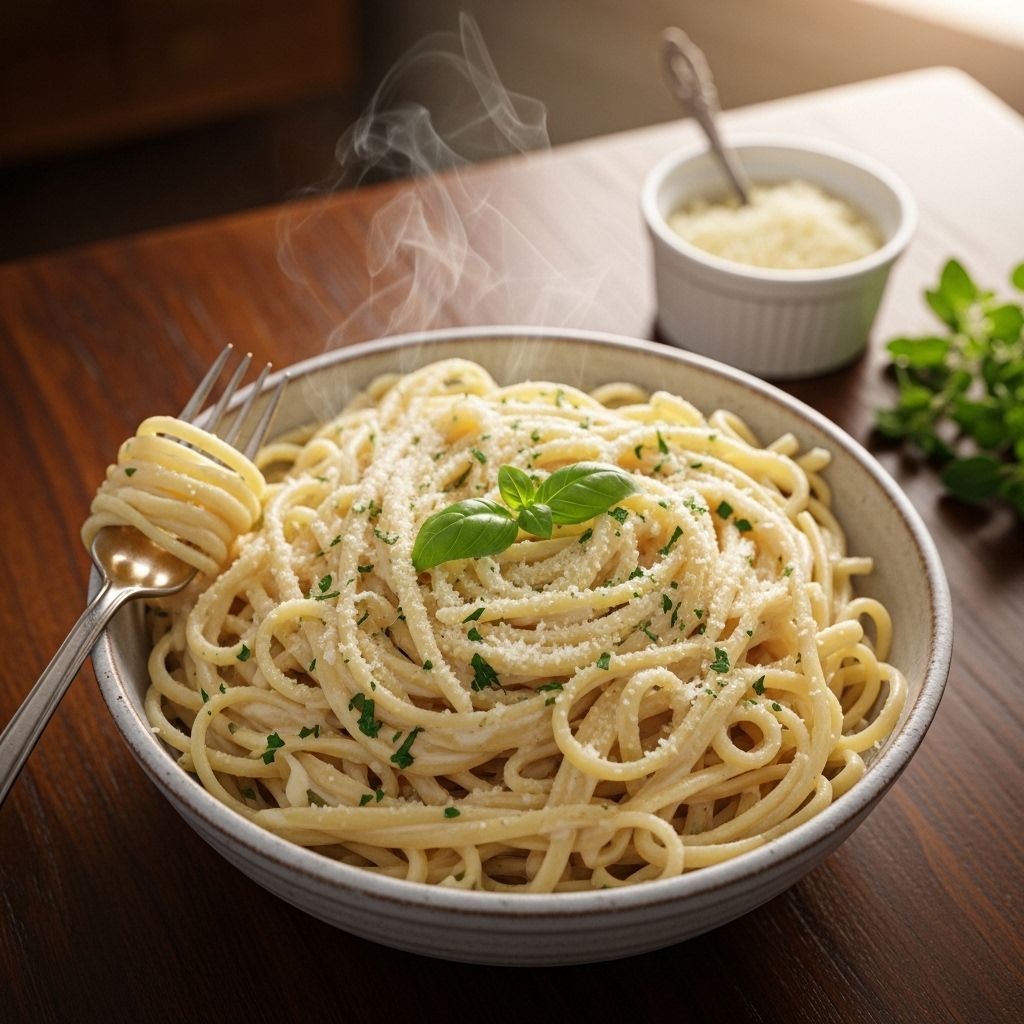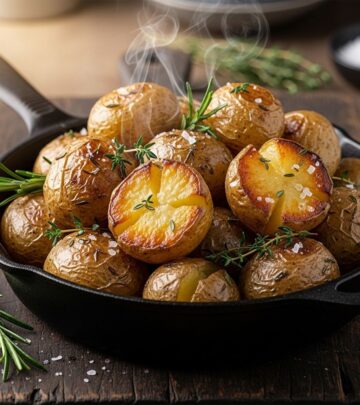Linguine Alfredo Recipe: 9 Ingredients For Creamy Perfection
Master the art of creating restaurant-quality Linguine Alfredo in your own kitchen

Image: HearthJunction Design Team
Introduction to Linguine Alfredo
Linguine Alfredo stands as one of the most beloved Italian-American dishes, combining the silky texture of perfectly cooked linguine pasta with a luxuriously rich, buttery cream sauce. This classic comfort food has earned its reputation as a restaurant favorite, but the good news is that you can create this indulgent dish in your own kitchen with just a handful of quality ingredients and about 30 minutes of your time.
The beauty of Linguine Alfredo lies in its elegant simplicity. Unlike many pasta dishes that rely on complex combinations of ingredients, Alfredo sauce celebrates the pure flavors of butter, cream, garlic, and cheese, allowing each component to shine through in perfect harmony. When these elements come together, they create a velvety sauce that clings beautifully to each strand of linguine, delivering a decadent dining experience that feels special enough for company yet simple enough for a weeknight dinner.
Ingredients Overview
One of the most appealing aspects of Linguine Alfredo is its straightforward ingredient list. You’ll need just a few high-quality components to create this restaurant-worthy dish at home:
- 1 pound (16 ounces) linguine pasta – The foundation of our dish, providing the perfect texture and surface area for the sauce to cling to
- 1 cup (2 sticks) butter – Provides richness and forms the base of our sauce
- 2 cups heavy cream – Creates the luxurious, velvety texture that defines a proper Alfredo
- 4 cloves garlic, minced – Adds aromatic depth and subtle flavor to the sauce
- 2 cups freshly grated Parmesan cheese – The star ingredient that provides both flavor and thickening power
- 1 teaspoon dried parsley flakes – Adds a touch of color and subtle herbaceous notes
- 1 teaspoon dried basil – Complements the creamy flavors with classic Italian herbaceous notes
- Salt and freshly ground black pepper – Season to taste
- Fresh parsley, chopped (for garnish) – Optional but recommended for a fresh finish and visual appeal
Equipment Needed
Before diving into the cooking process, gather these essential kitchen tools:
- Large pot – For boiling the linguine pasta
- Colander – For draining the cooked pasta
- Medium saucepan – For preparing the Alfredo sauce
- Wooden spoon or silicone spatula – For stirring the sauce
- Measuring cups and spoons – For precise ingredient measurements
- Cheese grater – For freshly grating the Parmesan cheese
- Tongs – Helpful for tossing the pasta with the sauce
Step-by-Step Cooking Instructions
Preparing the Pasta
The foundation of any great pasta dish begins with properly cooked pasta. For Linguine Alfredo, achieving that perfect al dente texture is crucial:
- Fill a large pot with water (about 4-5 quarts) and add 1 tablespoon of salt
- Bring the water to a rolling boil over high heat
- Add the linguine pasta to the boiling water, stirring gently to prevent sticking
- Cook the pasta according to the package directions, typically 8-10 minutes, until al dente (tender but still firm to the bite)
- Reserve about 1/2 cup of pasta cooking water before draining (this starchy water can help thin the sauce if needed)
- Drain the pasta in a colander, but do not rinse it (the starch on the pasta helps the sauce adhere)
Creating the Alfredo Sauce
While the pasta cooks, prepare the luscious Alfredo sauce that will transform the simple linguine into an extraordinary dish:
- In a medium saucepan, melt the butter over medium heat
- Add the minced garlic and sauté for about 1-2 minutes until fragrant and lightly browned, being careful not to burn it
- Pour in the heavy cream and bring the mixture to a gentle simmer (small bubbles around the edge of the pan)
- Reduce the heat to medium-low and continue to simmer for 3-5 minutes, allowing the sauce to slightly thicken
- Gradually add the grated Parmesan cheese, stirring constantly to ensure it melts smoothly into the sauce
- Stir in the dried parsley, dried basil, salt, and freshly ground black pepper
- Continue to cook the sauce for another 2-3 minutes, stirring frequently, until it reaches a smooth, velvety consistency
Combining Pasta and Sauce
The final step is bringing together the perfectly cooked linguine and the rich Alfredo sauce:
- Return the drained pasta to the empty cooking pot
- Pour the prepared Alfredo sauce over the linguine
- Using tongs or two large forks, gently toss the pasta until each strand is thoroughly coated with the creamy sauce
- If the sauce seems too thick, add a small amount of the reserved pasta cooking water to thin it to your desired consistency
- Taste and adjust seasonings as needed with additional salt and pepper
Serving Suggestions
Linguine Alfredo is best enjoyed immediately after preparation when the sauce is at its creamiest. Here are some serving suggestions to elevate your dining experience:
- Transfer the pasta to warmed serving plates or bowls
- Garnish with additional freshly grated Parmesan cheese and chopped fresh parsley
- Serve with a final crack of black pepper for added visual appeal and flavor
- Accompany with garlic bread or a simple green salad dressed with vinaigrette to balance the richness
Recipe Variations and Additions
While the classic Linguine Alfredo is perfect in its simplicity, there are several delicious variations you can try to customize this dish to your preferences or to create a more substantial meal:
Protein Additions
- Chicken Linguine Alfredo: Add grilled or sautéed chicken breast, seasoned with salt, pepper, and paprika
- Seafood Alfredo: Incorporate sautéed shrimp, scallops, or a seafood medley
- Italian Sausage Alfredo: Add crumbled, cooked Italian sausage for a heartier dish with a hint of spice
Vegetable Enhancements
- Primavera Alfredo: Fold in sautéed bell peppers, zucchini, and cherry tomatoes
- Mushroom Alfredo: Add sautéed mushrooms (cremini, button, or portobello) for an earthy flavor
- Spinach and Sun-Dried Tomato Alfredo: Stir in fresh baby spinach and chopped sun-dried tomatoes just before serving
Flavor Variations
- Truffle Alfredo: Add a drizzle of truffle oil or a small amount of truffle paste for an elegant twist
- Herb-Infused Alfredo: Incorporate fresh herbs like thyme, rosemary, or sage into the butter while melting
- Spicy Alfredo: Add a pinch of red pepper flakes or a dash of hot sauce for heat
Storage and Reheating Tips
Linguine Alfredo is best enjoyed fresh, as the sauce can separate when refrigerated and reheated. However, if you have leftovers:
- Store in an airtight container in the refrigerator for up to 3 days
- To reheat, place in a saucepan over low heat, adding a splash of cream or milk to revitalize the sauce
- Stir gently and frequently while reheating to help recombine the sauce
- Avoid microwaving if possible, as it can cause the sauce to separate and the pasta to become rubbery
Nutritional Information
Linguine Alfredo is undeniably an indulgent dish. While it’s best enjoyed as an occasional treat rather than an everyday meal, here’s an approximate nutritional breakdown per serving (based on 4 servings):
| Nutrient | Amount per Serving |
|---|---|
| Calories | 730-750 kcal |
| Total Fat | 50-55g |
| Saturated Fat | 30-35g |
| Carbohydrates | 45-50g |
| Protein | 15-20g |
| Sodium | 800-900mg |
Frequently Asked Questions
Q: Why is my Alfredo sauce grainy or separated?
A: This typically happens when the sauce is heated too quickly or at too high a temperature. To prevent this, keep the heat medium-low and add the cheese gradually, removing the pan from heat if necessary. Also, using freshly grated cheese (rather than pre-packaged) helps ensure a smooth sauce.
Q: Can I use milk instead of heavy cream?
A: While heavy cream provides the richest texture, you can substitute half-and-half for a lighter version. Regular milk will produce a much thinner sauce that may require a thickening agent like a roux (butter and flour mixture).
Q: Is it necessary to use both Romano and Parmesan cheese?
A: Traditional Alfredo sauce uses Parmesan cheese. Romano has a sharper, more assertive flavor, while Parmesan is nuttier and more subtle. Using a combination provides excellent depth of flavor, but you can use all Parmesan if preferred.
Q: How can I make this recipe lighter?
A: For a lighter version, you can replace some of the heavy cream with half-and-half, reduce the amount of butter, or incorporate pureed cauliflower into the sauce. Note that these substitutions will change the richness and texture of the final dish.
Q: Can Linguine Alfredo be frozen?
A: Cream-based sauces generally don’t freeze well as they tend to separate when thawed and reheated. It’s best to enjoy this dish fresh or refrigerated for a short period.
Chef’s Tips for Perfect Linguine Alfredo
Elevate your Linguine Alfredo from good to exceptional with these professional insights:
- Quality ingredients matter: Use the best quality ingredients you can find, especially the Parmesan cheese. Freshly grated cheese from a block will melt more smoothly than pre-grated varieties
- Temperature control is crucial: Keep the heat moderate to prevent the sauce from separating or the garlic from burning
- Slightly undercook the pasta: Cook the linguine 1 minute less than package directions if you’ll be tossing it with the hot sauce for a minute or two
- Don’t rinse the pasta: The starch on the surface helps the sauce adhere better
- Warm your serving dishes: Alfredo sauce thickens as it cools, so serving on warmed plates helps maintain the ideal consistency longer
With these detailed instructions and tips, you’re well-equipped to create a restaurant-quality Linguine Alfredo in the comfort of your own kitchen. This timeless Italian classic is sure to impress family and friends alike with its rich flavors and luxurious texture. Buon appetito!
References
- https://www.food.com/recipe/linguini-alfredo-5116
- https://www.allrecipes.com/recipe/23431/to-die-for-fettuccine-alfredo/
- https://noshingwiththenolands.com/linguine-alfredo/
- https://aliinthevalley.com/2021/03/31/homemade-chicken-linguine-alfredo/
- https://www.thepioneerwoman.com/food-cooking/recipes/a8885/fettuccine-alfredo/
Read full bio of Srija Burman












